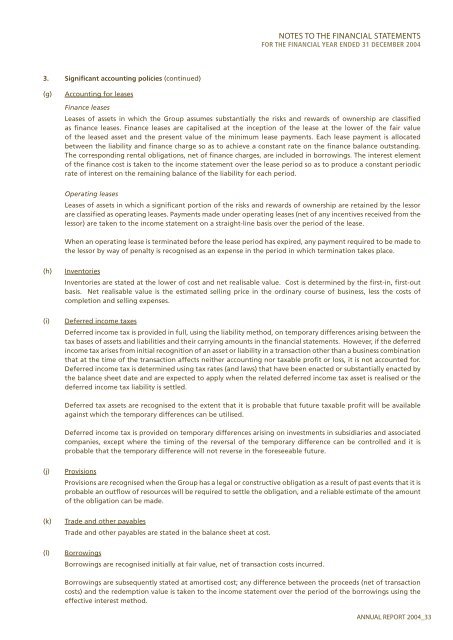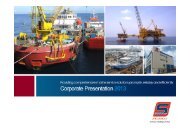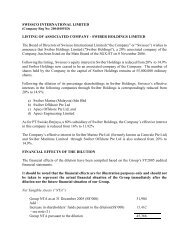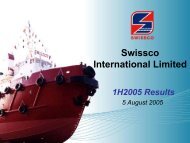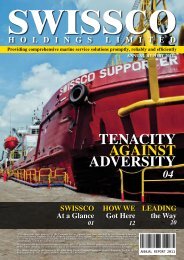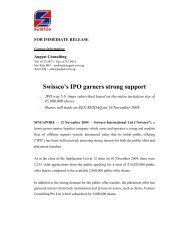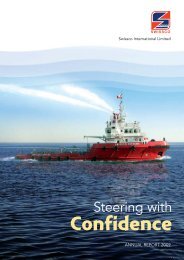SAILING THE SEAS OF SUCCESS - Swissco Holdings Limited
SAILING THE SEAS OF SUCCESS - Swissco Holdings Limited
SAILING THE SEAS OF SUCCESS - Swissco Holdings Limited
Create successful ePaper yourself
Turn your PDF publications into a flip-book with our unique Google optimized e-Paper software.
NOTES TO <strong>THE</strong> FINANCIAL STATEMENTS<br />
FOR <strong>THE</strong> FINANCIAL YEAR ENDED 31 DECEMBER 2004<br />
3. Significant accounting policies (continued)<br />
(g)<br />
Accounting for leases<br />
Finance leases<br />
Leases of assets in which the Group assumes substantially the risks and rewards of ownership are classified<br />
as finance leases. Finance leases are capitalised at the inception of the lease at the lower of the fair value<br />
of the leased asset and the present value of the minimum lease payments. Each lease payment is allocated<br />
between the liability and finance charge so as to achieve a constant rate on the finance balance outstanding.<br />
The corresponding rental obligations, net of finance charges, are included in borrowings. The interest element<br />
of the finance cost is taken to the income statement over the lease period so as to produce a constant periodic<br />
rate of interest on the remaining balance of the liability for each period.<br />
Operating leases<br />
Leases of assets in which a significant portion of the risks and rewards of ownership are retained by the lessor<br />
are classified as operating leases. Payments made under operating leases (net of any incentives received from the<br />
lessor) are taken to the income statement on a straight-line basis over the period of the lease.<br />
When an operating lease is terminated before the lease period has expired, any payment required to be made to<br />
the lessor by way of penalty is recognised as an expense in the period in which termination takes place.<br />
(h)<br />
Inventories<br />
Inventories are stated at the lower of cost and net realisable value. Cost is determined by the first-in, first-out<br />
basis. Net realisable value is the estimated selling price in the ordinary course of business, less the costs of<br />
completion and selling expenses.<br />
(i)<br />
Deferred income taxes<br />
Deferred income tax is provided in full, using the liability method, on temporary differences arising between the<br />
tax bases of assets and liabilities and their carrying amounts in the financial statements. However, if the deferred<br />
income tax arises from initial recognition of an asset or liability in a transaction other than a business combination<br />
that at the time of the transaction affects neither accounting nor taxable profit or loss, it is not accounted for.<br />
Deferred income tax is determined using tax rates (and laws) that have been enacted or substantially enacted by<br />
the balance sheet date and are expected to apply when the related deferred income tax asset is realised or the<br />
deferred income tax liability is settled.<br />
Deferred tax assets are recognised to the extent that it is probable that future taxable profit will be available<br />
against which the temporary differences can be utilised.<br />
Deferred income tax is provided on temporary differences arising on investments in subsidiaries and associated<br />
companies, except where the timing of the reversal of the temporary difference can be controlled and it is<br />
probable that the temporary difference will not reverse in the foreseeable future.<br />
(j)<br />
Provisions<br />
Provisions are recognised when the Group has a legal or constructive obligation as a result of past events that it is<br />
probable an outflow of resources will be required to settle the obligation, and a reliable estimate of the amount<br />
of the obligation can be made.<br />
(k)<br />
Trade and other payables<br />
Trade and other payables are stated in the balance sheet at cost.<br />
(l)<br />
Borrowings<br />
Borrowings are recognised initially at fair value, net of transaction costs incurred.<br />
Borrowings are subsequently stated at amortised cost; any difference between the proceeds (net of transaction<br />
costs) and the redemption value is taken to the income statement over the period of the borrowings using the<br />
effective interest method.<br />
ANNUAL REPORT 2004_33


